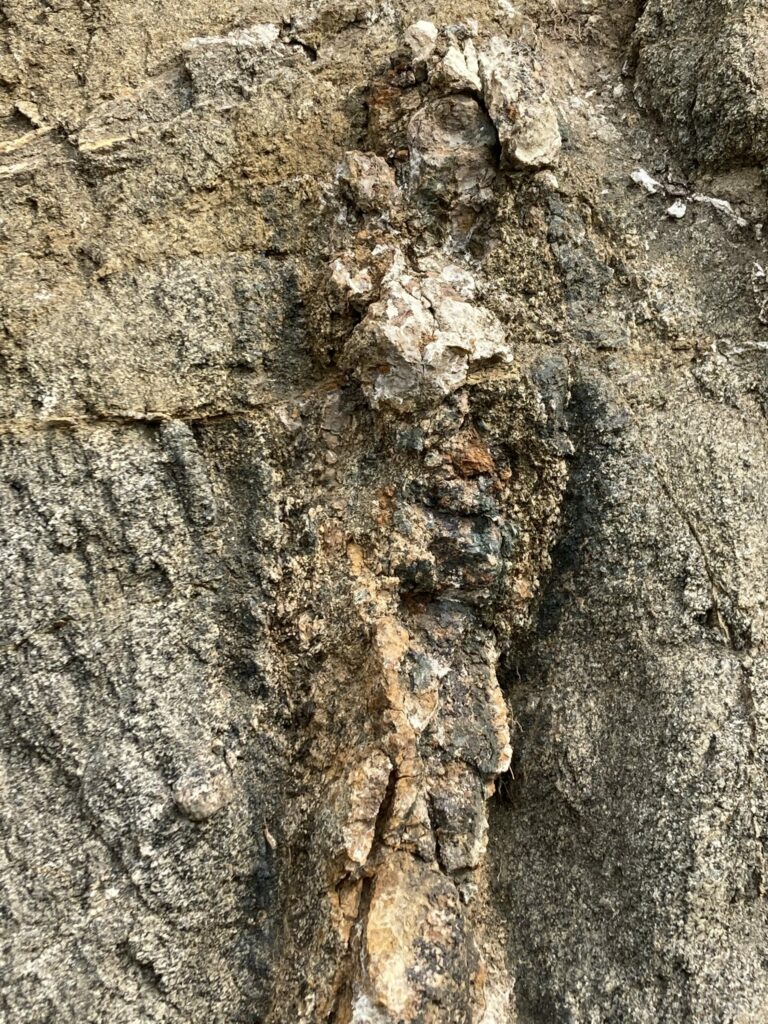Significant Mineralization Confirmed At Depth
Sheep Creek stands apart from most U.S. rare earth projects because significant mineralization has been directly accessed underground through historic mine workings.
US Critical Materials has confirmed rare earth mineralization at depth below high-grade surface samples (17.05% TREO and 16.44% TREO). These samples analyzed by Activation Laboratories (Act Labs) and Idaho National Laboratory (INL) show high levels of rare earths 150–400 feet below the surface.
Two historic adits, Adit #1 and Adit #3, excavated in the late 1950s in pursuit of niobium, extend about 400 feet horizontally into the hillside. Though sealed since the 1960s, they now provide direct access to carbonatite dikes and veins carrying rare-earth mineralization—an advantage unmatched by other U.S. projects.
Replicating this kind of confirmation today would require costly permitting and approvals. Because the adits are historic and grandfathered, US Critical Materials can explore them without these burdens, saving significant time and expense.
By confirming substantial underground mineralization, Sheep Creek places US Critical Materials ahead of competing domestic projects that remain tied up in permitting or testing low-grade deposits.

Sheep Creek
Provide Secure Supply
US Critical Materials Corp. intends to work with the US government and US corporations-especially auto-manufacturers, to provide a secure supply of rare earths and critical minerals.
Exploration & Development
The properties contain at least 12 of the critical risk elements as defined by the U.S. Geological Survey. The key property elements include high levels of neodymium and praseodymium.
Highest Grade
Sheep Creek is one of the highest-grade light rare earth projects in the US. Sampling has produced average TREE (total rare earth elements) of 9%
Adit #1
The carbonatite exposed in Adit #1 is up to 3 feet in width and can be followed for 270 feet along the drift. Ancylite is present throughout the underground workings. 12 rock-chip channel samples were collected from Adit #1. A grab sample of ancylite-bearing carbonatite analyzed in 2021 from a surface outcropping of the dike, about 50 feet above Adit #1 contained 16.44 % total rare-earth oxides, including: 16,563 ppm (1.66%) neodymium oxide; and 6,261 ppm (0.63%) praseodymium oxide.

Adit #3
The carbonatite exposed in Adit #3 is accessed by a crosscut approximately 400 feet long at which point it intersects a northwest-southeast trending carbonatite that is developed over approximately 120 feet. The carbonatite in the mine workings correlate to carbonatites exposed in a trench cut 125 vertical feet above the adit. The carbonatite in Adit #3 has been measured in places at over 4 feet in width and is strongly banded with ancylite, allanite and monazite. Nine rock-chip channel samples were collected from Adit #3 and measured. A grab sample of ancylite-bearing carbonatite analyzed in 2021 from the trench above the adit contained 17.05% total rare-earth oxides, including: 15,746 ppm (1.57%) neodymium oxide; and 6,249 ppm (0.62%) praseodymium oxide.
A grab sample of carbonatite from the mine dump of Adit #3 (sample 21004) contained 7.26% total rare-earth oxides, including: 8,398 ppm (0.84%) neodymium oxide; and 3,101 ppm (0.31%) praseodymium oxide.
An XRF scan of the carbonatite underground in Adit #3 showed 8.7% cerium, 6.9% lanthanum, and 2.8% strontium.
